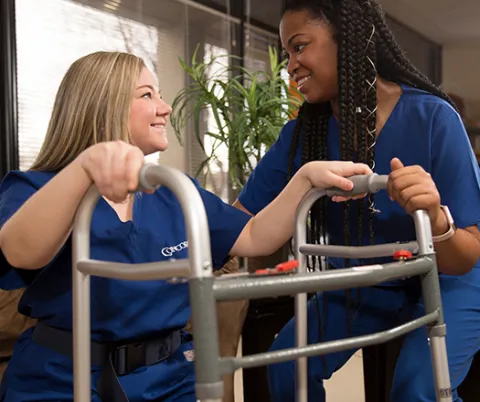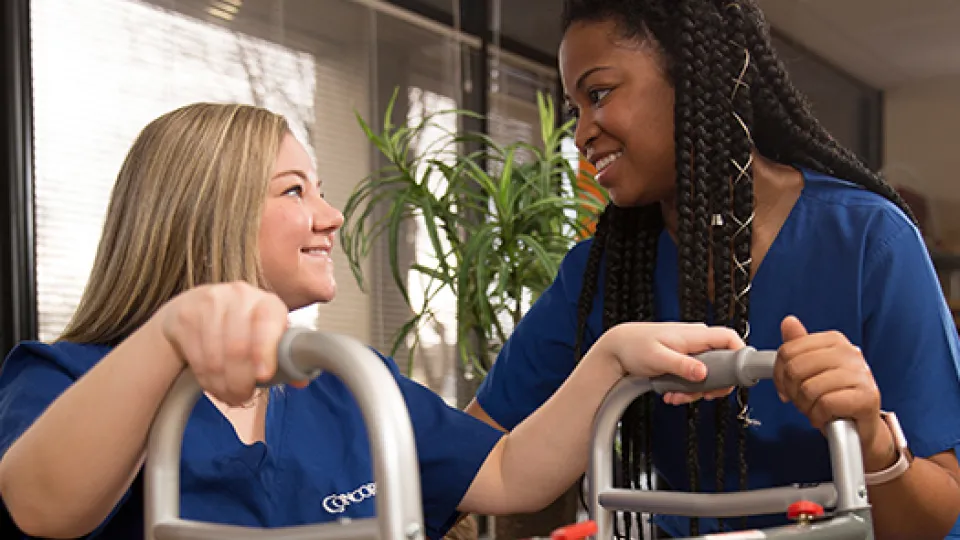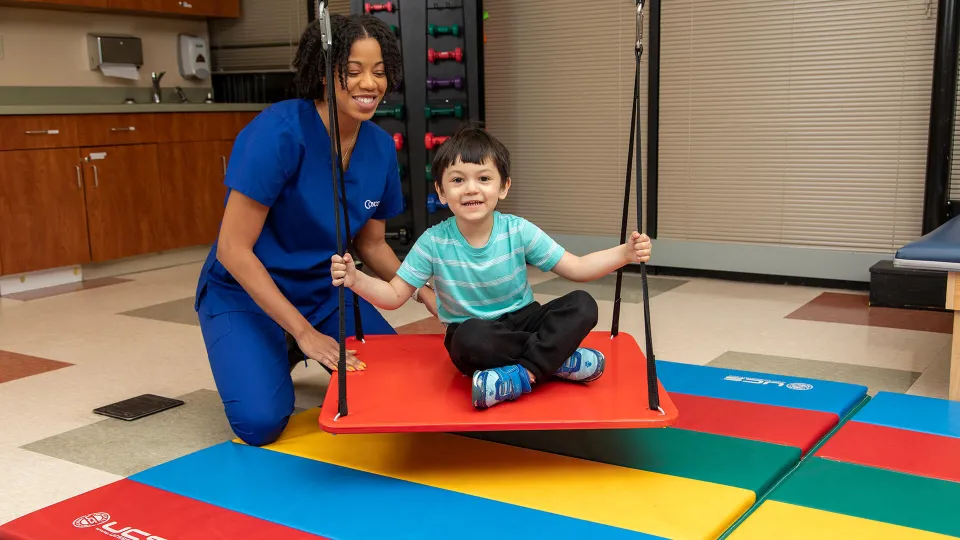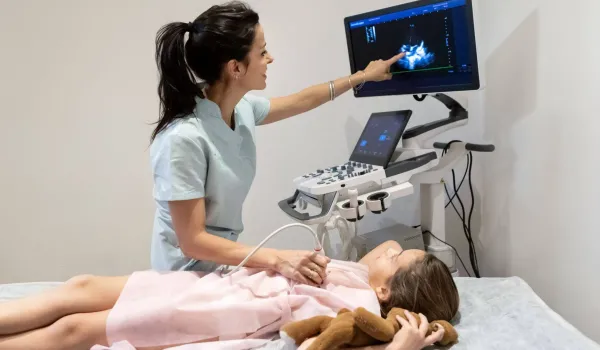Concorde Staff

Occupational therapy is a field that helps people regain physical function or adapt to daily life after a traumatic incident has left them unable to use their body in their accustomed ways. The role of the occupational therapy assistant (OTA) is that of helping occupational and physical therapists with patients, but the OTA also has roles where they work on their own in the pursuit of helping others.
An OTA can work in settings like these in order to help people adapt to their environment through the use of aids and/or tools:
| Work Environment | Roles of OTAs |
|---|---|
| Hospitals | Assist in rehabilitation and recovery |
| Schools | Support children with disabilities |
| Rehabilitation Centers | Help with recovery from injuries |
| Senior Living Communities | Aid seniors in maintaining independence |
| Home Health | Provide in-home care |
| Non-clinical Roles | Positions like clinical liaison, educator, or researcher |
They may find themselves working with toddlers, children, or elderly patients to help them work with changes in their bodies. It's a role that offers high job satisfaction for people who want to help others improve their lives. The OTA also has employment opportunities that go beyond working in clinics while still helping people live their best life possible.
Places Where an Occupational Therapy Assistant Can Find Employment

How To Become an Occupational Therapy Assistant
The occupational therapy assistant has many job paths available to them that can provide a fulfilling work experience. They can work in hospitals, rehabilitation facilities, assisted living homes, and more. This means that an occupational therapy assistant can pick a specialty and focus their education in order to pursue a career in that area. In the event the chosen specialty isn't satisfactory, the occupational therapist can fall back on their training to pick another specialty and find an area of work that does offer job satisfaction. Here's a look at the places an occupational therapist can find work.
Physical Therapy Clinics
The role of an occupational therapy assistant differs from that of the physical therapist, but the work of an OTA is complementary to that of the PT. A physical therapist helps the patient regain control of their body after recovering from an injury. On the other hand, the OTA helps the patient recover their motor skills and strength while showing them how to adapt to the changes in their body so they can return to their daily activities.
Occupational Therapy Clinics
It seems obvious that an occupational therapy assistant will find themselves working in a clinic that focuses on occupational therapy, but it's not as straightforward as it would seem. Occupational therapy clinics sometimes focus solely on pediatrics, geriatrics, physical rehabilitation, living with disabilities, environmental modification, and more. This specialization makes it easier for an OTA to find a place of work that reflects their chosen specialty. OTAs who want more challenge from their work may find satisfaction working in a clinic that takes all manner of patients who present a variety of needs on a daily basis.
Medical Rehabilitation Clinics
Medical rehabilitation clinics focus on helping patients who have lost physical function due to a traumatic event such as a car accident or injury on a job site. Patients in this type of setting have lost their ability to move their bodies in the fashion they were accustomed to prior to the event. The OTA helps these patients find new ways to use their bodies and creates devices that allow a patient to perform a simple task with the least amount of effort.
This type of work can be very intense because the OTA is working to help people regain their ability to perform basic tasks and/or return to work. The on-the-job education an OTA receives in this setting can help them grow in their career.
Drug and Alcohol Rehab Centers
The reason for addiction comes in all forms, but the effects on the body can be devastating. Some people become addicted to pain killers while others use alcohol as a form of self-medication. Long-term alcohol abuse can lead to changes in the brain that resemble dementia, and pain killers are used for relief from chronic pain. With alcoholism, an occupational therapy assistant can help the patient regain the use of their motor skills.
Chronic pain sufferers benefit by learning how to move in ways that avoid the pain and remember to move around regularly to prevent pain from becoming worse. The OTA can also help the pain sufferer learn to use aids and tools to help them go about their daily lives and avoid incurring more pain.
Assisted Living or Halfway Homes
The assisted living or halfway house is a residential setting where residents learn how to live their lives independently. This can include teaching people how to cook, balance a checkbook, practice personal care and hygiene, perform duties at a place of employment, and complete other basic tasks of daily life that the patient may need to learn or relearn.
An OTA provides calm and steady guidance for people who are facing a return to daily life after spending an extended period of time in an institution. They help residents learn how to adapt to a world that has changed since the resident entered an institution.
Home Health Care
Patients who return from a stay in the hospital or rehabilitation facility can face challenges adapting to a new way of life in a familiar setting. The OTA evaluates the patient's issues and their home in order to devise ways the patient can maneuver around the furniture and other obstacles. Sometimes patients return to their homes with walking aids or canes and need to learn how to use the aid in their home.
The OTA can also help the patient use devices or aids to perform other daily tasks so the patient can stay in their home longer and not rely on caregivers for assistance. This assistance helps patients stay out of a nursing home, where they may not thrive as well as they would at home.
Schools
An OTA can find work in schools assisting children with special needs as they go about their school day. The OTA helps students find ways to adapt to the school environment, find an adaptive method to handle pens and pencils, and create modifications so students can use school equipment for their school work.
The overall goal of the OTA in the school setting is to help the student find ways to make the day as normal as possible and integrate with the rest of the student body. The OTA can also help students get to and from school in specialized transportation designed to accommodate mobility aids and wheelchairs.
What Else Can an Occupational Therapy Assistant Do With Their Degree?

What Does an Occupational Therapy Assistant Do?
The skills that an OTA gains from their education and employment can be applied in many non-clinical occupations. Some jobs are found in the medical field but don't require direct contact with patients. Other positions seek out occupational therapy assistants to work as consultants and educators. The role of an OTA is one that has a lot of potential for someone who wants to work in a field that is full of challenge and mental stimulation. Following are some of the occupations an occupational therapy assistant can work in that are not patient-facing.
Clinical Liaison
The role of a clinical liaison is a pseudo marketing role that involves reviewing records from potential patients and determining if they're a good fit for the facility and finding patients to come to the facility. The person who works in a liaison role has to be skilled in patient evaluation and have the forethought to discuss the facility with medical professionals and the general public. The goal is to raise awareness of the facility and its services along with determining which patients are a good fit for the facility and admitting them in a timely manner.
The clinical liaison needs to have a background in reading medical charts and orders and evaluating the health problems the patient is presenting. They also have to read the orders that accompany the patient in order to determine if the facility can provide the type of care that's requested by the order. An OTA who has worked in a clinical setting has learned how to do this as part of their role and can apply it to the job of the clinical liaison with ease. There are other challenges that come with this role that can help the OTA broaden their skill set and potentially find other non-clinical roles in the future that have a higher level of responsibility.
Clinical Educator
One of the aspects of working as an OTA is being an educator. The OTA teaches patients how to learn new methods of doing simple and complex tasks, and that requires the ability to communicate and demonstrate. Working as a clinical educator takes advantage of the medical knowledge and teaching skills used for working with patients one-on-one. The OTA-turned-clinical educator can lead a classroom and share their knowledge with students who are seeking to become an occupational therapy assistant themselves.
Utilization Review
Insurance companies are seeking medical professionals to work as utilization reviewers in order to better manage claims for reimbursement. The OTA reviews clinical documentation from health care providers in the network and uses the information to determine if therapy services should begin or be continued.
This position requires knowledge of how therapy is provided and the conditions that indicate a patient should undergo occupational therapy. An OTA helps the insurer make better-informed decisions about providing therapy to those who are in need. It's an office-based job that has little to no patient interaction, but the OTA does work with other clinicians throughout the course of the day and collaborates in the use of clinical judgment for each case.
Telehealth
The use of the word "telehealth" suggests that the work is performed over the telephone, but telehealth refers to any form of contact through electronic means, including the telephone. That can be a video chat, text conversation, email, or typed conversations within a portal. This still involves working with patients and providing them with advice for their particular condition, but it takes place remotely and uses technology to communicate. A patient describes their issue and the provider responds with therapeutic advice. The conversations can last anywhere from a few moments to an hour or more.
Telehealth is starting to become a larger part of healthcare and is used in areas where hands-on contact isn't an immediate necessity. An OTA who wants to leave the clinic but stay in the field may find that the telehealth arena is a perfect fit for them.
Contract Therapy
A contract therapy position involves working for a contracted period of time in different clinics. Instead of working at one clinic for an unknown length of time, an OTA works for multiple clinics for a short period of time. Most contracts start out at 13 weeks and sometimes last longer.
Contract therapy is an opportunity for an OTA to travel to different clinics and interact with a variety of patients, settings, and other clinicians. The OTA gets to expand their knowledge while being paid for it and avoids getting caught up in a clinical setting and the potential issues that come with a fixed workplace.
Ergonomic Specialist
This is an area where the occupational therapy assistant can really shine. Sitting in a chair at a desk all day has been shown to have negative effects on workers' health. Office managers are responding by making ergonomic adaptations. An OTA is brought in to observe how people interact with computer equipment and their surroundings in order to uncover sources of repetitive strain injury.
Once the OTA determines areas that can cause injury due to a lack of ergonomics, they can show how people can change their posture and hand positions to alleviate the strain. An OTA can provide suggestions for ergonomic office furniture that helps people move around while sitting at their desks and avoid aches and pains from sitting too much.
The role of an OTA is that of helping people live their day-to-day lives through the use of aids or taking stress off their bodies while they recover from an injury. The role is part caregiver, part educator, and part creator due to the need to find creative solutions for an existing problem.
Contact Concorde today to learn more about how our Occupational Therapy Assistant program can help prepare you for your career path in as few as 20 months.
Interested In How To Become an Occupational Therapy Assistant?
Click here to explore Occupational Therapy Assistant Programs near you!
"The Job Outlook for Occupational Therapy," American Occupational Therapy Association, https://www.aota.org/Education-Careers/Considering-OT-Career/JobOutlook.aspx
"Non-Clinical Occupational Therapy (OT) Jobs," The Non-Clinical PT, https://thenonclinicalpt.com/non-clinical-occupational-therapy-jobs/

Take The Next Step Towards a Brighter Future
Interested in learning more about our Occupational Therapy Assistant program? We have a Concorde representative ready to talk about what matters most to you. Get answers about start dates, curriculum, financial aid, scholarships and more!






